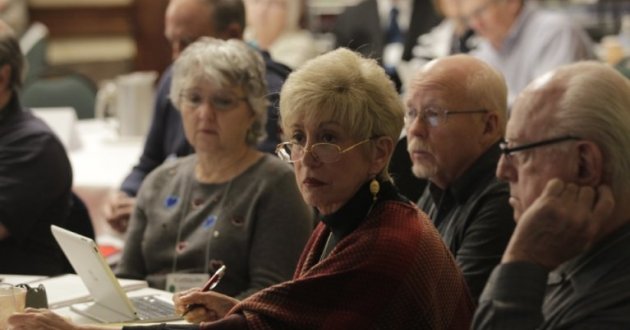This title has had a long history and was coined by IMF co-founder Susie Novis Durie when she first established the Caregiver Breakout Sessions in the IMF’s Patient and Family Seminars but more on that later.
Currently, it seems that “care partner” is in vogue to describe those assisting myeloma patients. However, from my personal perspective, it is important to distinguish the differences between a primary care partner and a care partner.
For purposes of definition, the IMF sees caregivers as the patient’s partner throughout the myeloma journey, thus the term “care partner.”
Having a myeloma diagnosis can be equally devastating for both the patient and their loved ones, who must step in as the patient’s primary care partner throughout their myeloma journey.
A spouse or significant other, or a family member who lives with and provides care for a patient on a day-to-day are considered primary care partners. A primary care partner walks alongside a patient loved one to help them live well with myeloma and provides essential physical, emotional, and practical support to the patient.
However, primary care partners are also thrust into an unfamiliar world of medical treatments, terminology, and appointments. This is why mutual support between the patient and the primary care partner is important—it is a partnership through thick and thin because both the patient and primary care partner need to learn about the complexities of the disease and treatments needed, as well as make important decisions together.
Meanwhile, those who assist the patient in a variety of ways, in varying degrees of partnership or as part of a broader support network, are considered as care partners.
Many myeloma patients have a primary care partner plus an extended network of additional support.
A primary care partner’s role is often sudden and brought about by necessity where they find themselves climbing a steep and daunting learning curve. Because of that, they may face many challenges while fulfilling their essential day-to-day responsibilities.
Short- and long-term needs of the patient are immediate concerns, and a primary care partner is faced with assessing personal capabilities to meet these needs. Therefore, looking to establish a support network is frequently on top of a primary care partner’s to-do list.
The patient’s ongoing and ever-evolving needs will become top priority, and self-care will most likely be neglected. However, ultimately, primary care partners will realize that self-care is just as necessary. When well-being is neglected, one’s capabilities to take care of a patient will also be considerably diminished.
Keep in mind that going through a myeloma journey is a marathon, not a sprint. The first part of the journey will bring fear over an unknown new disease but will transition into deeper understanding and realization—with careful and diligent management, positive and long outcomes can be achieved. All throughout one’s myeloma journey, resilience will undoubtedly need to be enhanced.
The Basic Needs of a Myeloma Patient
It takes time for the diagnosis of myeloma to sink in. Although excellent treatments are available and 5- to 10-year survival is highly likely in 2024, longer-term outcomes are less certain.
Being flooded with questions can be overwhelming: Will keeping a job be possible? Will I be able to maintain health insurance coverage ? How well does Medicare work with a myeloma diagnosis? Will the treatment be effective in my case? Will my bone pain get better?
Both husband and wife or partners are wondering if they will be able to cope. Their lives will surely be changed forever.
Making A List: An Indispensable Strategy
In approaching how to manage the complex issues which emerge with a myeloma diagnosis, making a list of questions for each category would be an excellent strategy.
I would suggest making a list for each of these categories:
- What exactly is myeloma? Do I need to see or consult with an expert?
- What treatment options are available?
- Can my spouse or significant other take me on appointments and take notes?
- Who is going to keep track of all medications?
- Will I be able to manage symptoms and side effects?
- Will a nurse or professional be required to assist at home?
- Will I need assistance to take care of children or pets?
- What about cooking, household chores, shopping and running errands?
- What about insurance paperwork? Will I need assistance?
- Is medical leave an option?
- Can we survive financially?
- Do I need to set up an Advance Health Care Directive or a Power of Attorney?
- I am alone, so I will definitely need a support network. Which IMF Support Group should I reach out to?
Depending upon the situation, there may be more specific needs: a walker, a brace or wheelchair, or transportation assistance.
A Primary Care Partner’s Tasks
A myeloma diagnosis brings about a paradigm shift in one’s daily life. What used to be shared responsibilities may now become the primary care partner’s sole tasks.
Intimate relationships may not be possible for the time being. Dealing with required paperwork for health insurance, Medicare coverage, and finances may become an overwhelming challenge. It may involve including more decisionmakers such as trusted friends, your physician, and care partners. It may also involve reaching out to myeloma experts to ask specific questions.
The primary care partner may have to accompany the patient during doctor’s visits and may need to listen carefully, especially when the patient becomes anxious and less receptive to what the doctor says.
To avoid being overwhelmed, it’s important for the primary care partner to understand that while myeloma is currently still incurable, it is a highly treatable disease. The reality of a myeloma diagnosis may take a while to process and future expectations may be radically altered: Will we still be able to visit our grandkids or go on vacations?
To know more about the roles and responsibilities of primary care partners, as well as tips and advice on self-care, visit the IMF Care Partner page.
Why Having a Support Care Team is Necessary
The daily status of a myeloma patient is very important. The primary care partner can detect and report changes such as increasing weakness or pain, for example. With new immune therapies such as CAR T and bispecifics, key toxicities need to be consistently monitored.
As an example, a patient getting CAR T therapy will need to have a primary care partner present before, during, and after treatment. The primary care partner’s role is especially crucial after an infusion and during the recovery phase, where signs and symptoms of side effects from the treatment need to be closely monitored. The primary care partner needs to have a deep understanding and knowledge of what signs and symptoms to watch out for.
Does the patient have a fever? Are there indications of cytokine release syndrome (CRS)? What type of side effects are manifesting? Are there changes to taste or sense of smell? Are skin, nails, or eyes exhibiting side effects?
If the patient is exhibiting any of these signs and symptoms, the primary care partner needs to notify the patient’s healthcare team immediately. Joint doctor appointments can provide specific plans on what to look out for and what next steps should be taken.
Additionally, when a patient is undergoing intensive immune regimen treatments, having a Support Care Team is a REQUIREMENT in the approval process, not an option.
Why a Team Strategy Makes Sense
A primary care partner’s role is immensely important—the “quarterback” who will guide, direct, and work with a support care team. They are constantly around and in charge, but they are humans too—they can become sick or unavailable. Therefore, it is of paramount importance to have back-up when this happens. This is what’s called a Team Strategy approach.
To cope with the demands and issues of caregiving over time, establishing a support network is essential. The primary care partner is a key member of the treatment support team, ensuring that the team functions to the best of its ability.
Family members, friends, and trained professionals can help with many things. The attending doctor, nurses, and clinic/ hospital team provide the core group for the working care team.
These are areas where having a treatment support team can help:
- Covering for a primary care partner who is sick or unavailable
- Running simple errands; shopping for essentials; and/or picking up prescriptions
- Preparing meals or making sure that they are available. Fortunately, food delivery options are now widely available, post-pandemic.
- Initiating wellness activities, such as walking or regular exercise
- Assisting with household chores, such as cleaning or doing laundry
- Providing childcare or taking care of pets
- Providing transportation to and from doctor appointments, clinic or hospital visits
- Having a trustworthy and reliable team of doctors, nurses, and staff at the clinic or hospital to assist with direct treatment and/or other medical needs. They can be a part of a shared decision-making team.
These are just examples. Many diverse needs can still emerge over time.
The IMF: Caring for Caregivers Since 1990
As I’ve previously pointed out, “Caregivers need care too” was a line coined by IMF co-founder Susie Novis Durie for the Caregiver Breakout Sessions that were held during Patient and Family Seminars. These breakout sessions were uniquely designed for family members to have a safe space for personal discussions about their respective myeloma journeys.
It’s important to note that IMF co-founder Susie Novis Durie herself became a caregiver to her husband, Brian Novis when he was diagnosed with myeloma at age 33. Instead of feeling anxious and hopeless about the “dearth of resources and information for patients and their loved ones,” Susie, Brian, and I took a proactive stance and established the International Myeloma Foundation in 1990— dedicating our lives to the IMF’s mission of “improving the quality of life of myeloma patients while working toward prevention and a cure.”
Susie understood what it meant to be a caregiver in every way—from the emotional toll to having presence of mind to be able to go about the day-to-day care of her husband. In her Dear Reader column on the 2024 Winter Edition of Myeloma Today, Susie narrated the history of the IMF—from its inception in 1990 to what it has become today.
In those 34 years, Susie dedicated herself and strived very hard to establish support systems for caregivers.
Today, Care Partner Breakout Sessions are still being held at patient seminars, support group meetings, and other venues where private, safe, and confidential discussions can be had.
As Susie has emphasized so many times, you are not alone, and mental and emotional issues are to be expected.
Knowledge and support from other caregivers can guide your way forward. Seeking professional help is normal and highly encouraged. Joining a wellness program can also be very helpful in maintaining one’s good health and well-being.
The Bottom Line
Providing the best care for a myeloma patient requires a planned approach— systematic and efficient teamwork between primary care partners and their respective support care teams, with long-term survival and good quality of life as collective primary goals.
Having a team strategy helps immensely with side effect management. Working in partnership with a strong support care team often yields positive outcomes for both the caregiver and the patient.
Remember that you are NEVER alone, and that the IMF is always ready to help. Contact the IMF’s InfoLine team for your myeloma-related questions and concerns at 1-800-452-CURE (2873) or by emailing infoline@myeloma.org.
 Professor of Medicine, Hematologist/Oncologist, and Honoree MD at the University of Brussels, Dr. Brian G.M. Durie is Chairman Emeritus and Chief Scientific Officer of the IMF. Dr. Durie is also the Chairman of the International Myeloma Working Group (IMWG)—a consortium of more than 250 myeloma experts from around the world—and leads the IMF’s Black Swan Research Initiative® (BSRI).
Professor of Medicine, Hematologist/Oncologist, and Honoree MD at the University of Brussels, Dr. Brian G.M. Durie is Chairman Emeritus and Chief Scientific Officer of the IMF. Dr. Durie is also the Chairman of the International Myeloma Working Group (IMWG)—a consortium of more than 250 myeloma experts from around the world—and leads the IMF’s Black Swan Research Initiative® (BSRI). 






